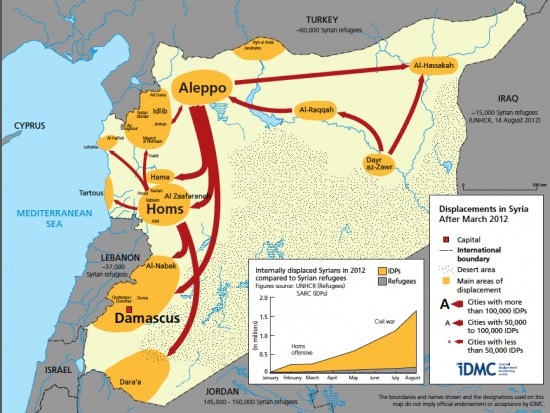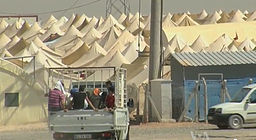Despite the recent victory in Qusayr by the pro Al-Assad groups, and despite the strategic character of the city, this scenario seems to be unlikely, but not impossible, in a very near future.
To obtain complete victory, we may assume that the regime of Bashar Al-Assad would continue and even strengthen his current strategy of population displacement and use of foreign forces. However, this strategy has profound impacts that would make the construction of peace much more difficult: it favours sectarianism, the spiral of fear, hatred, and retribution, while destroying wealth and thus making it more difficult to deal with displaced people and providing for their return to normal life.
As underlined almost a year ago by Joshua Landis:
“The broader Alawite community fears the possibility of aimless retribution. To avoid this, Assad is likely to pursue the Lebanon option: turn Syria into a swamp and create chaos out of Syria’s sects and factions. It is a strategy of playing upon divisions to sow chaos.” (Creating a Syrian Swamp: Assad’s ‘Plan B’”, for Syria Comment, August 10, 2012)
Joseph Holliday excellent report, The Assad Regime: from Counterinsurgency to Civil War (March 2013 for the ISW, notably pp.19-23), provides for an account of the regime’s strategy in terms of populations’ displacement, aiming at separating “the rebellion” from a potential basis. According to him, starting from the months following the shelling of Homs in February 2012, it was increasingly pursued intentionally (p.19, also “Syria’s Mutating Conflict,” International Crisis Group, August 2012: 6-7). Before that, it would also have been done “at least in Alawite-majority coastal regions,” where “repeated clearance operations in coastal Sunni enclaves took place” (p.19). It is done in five ways:
- Use of artillery shelling on towns and neighborhoods, or “scorched earth policy” (Holliday: pp.19-20, ICG: 6-9)
- Campaign of bulldozing neighborhoods in Damascus and also Hama with assistance of paramilitary troops to expel people (Autumn 2012 – pp.21-22)
- Massacres of men, women, and children in Sunni villages and neighborhoods across Syria by pro-regime militia, notably in areas close to Alawite villages and neighborhood (pp.21-22). Holliday however underlines that “Although pro-regime militias have been primarily responsible for these killings, it is difficult to exonerate the regime of responsibility in most cases.” (p.21)
- Air power, including the use of helicopters and so-called “barrel-bombs” (improvised bombs constructed from oil drums and dropped by Syrian helicopters,” incendiary device aiming at better destroying buildings), the targeting of bakeries pp.22-25).
- Use of Surface-to-Surface Ballistic Missile (SSBM) against the population starting from January 2013 (pp.24-25).
As a result, the number of refugees and internally displaced persons increases exponentially. In April, according to the AFP more than 60.000 had died (until November 2012), while 1.2 million had fled to neighbouring countries and 4 million were internally displaced. On 13 June 2013, the UN estimates that at least 93.000 people had died so far during the conflict (BBC News, 13 June). On 17 June, 1.64 million people are refugees in other countries, according to UNHCR ongoing estimates and Syria counts 4.25 million Internally Displaced Persons (IDPs) according to USAID and the Internal Displacement Monitoring Center.

Everything being equal, for any student of Cambodia, the situation has an eerie feeling of déjà vu in terms of refugees (during the 1970-1975 war, during the Democratic Kampuchea – Khmer Rouge regime – and after), of emptying of cities and towns (by the Communist Party of Kampuchea (CPK) – the “Khmer Rouge” – once victory was achieved) and violence against one’s own population. It is not by chance that Holliday uses in his report the term of “cleansing”. Hopefully for Syria and for Syrians, the comparison will stop there. Nevertheless, considering the very high tension in the country, not only since the beginning of the civil war, but also previously, as Syria has been under a state of emergency between 1963 and April 2011, the very destruction of the social fabric brought about by the way the civil war is waged, as noted by Lyse Doucet in her “Qusair – the Syrian city that died” (BBC News, 7 June 2013), it is hard to imagine how a victorious Al-Assad regime could rule by any other means than fear and again emergency, to remain positive and not to jump to hasty conclusions.
The help and support of the victorious regime’s allies would then be crucial to avoid seeing paranoia, violence and retribution settling in.
Although it would be diplomatically complex, if not impossible, to implement, Syria would have to be brought back in the family of nations as quickly as possible for the same reasons. Any pressure would have to be exerted with the utmost caution while also and always thinking in terms of impact on civilian populations. Failure to do so could lead to very adverse consequences for the population. It could also have the potential to create a core block of states (Iran, Iraq, Syria) with whom relations, for many other countries, would be tense. Russia and China would then have the power to act as balancing weight.
Estimating Likelihood for Scenario 3.4.
if we consider the forces on the ground (forthcoming post), this scenario is the least unlikely of the last four we outlined. However, the likelihood to see a real and complete victory, followed by a peace, are still slim.
Some indicators that could be followed as influencing the likelihood of this scenario:
- the type of support granted to the various insurgent groups;
- the capacity of the insurgent groups to unite and be efficient;
- the way the insurgent groups will fight and mobilize the population, including succeeding or failing to protect them against the population displacement of the Al-Assad regime;
- the support and level of protection insurgent groups and civilian populations could obtain with certainty after victory;
- the level of threat, both external and internal, felt by the victorious power;
- the kind of support given to the new Syrian regime;
- the capacity to integrate again the new Syria in the international society of states;
- the way refugees and IDPs are reintegrated (and the support negotiated, i.e. granted and accepted);
- the power and wisdom of various trade networks in favouring sustainable and fair business;
- the interest and play of various organised crime networks in the situation in Syria.
This scenario ends our series of scenarios for Syria in the short to medium term future.
Header image: Bashar al-Assad visiting The tomb of the Unknown Soldier by Syrianist (Own work) [CC-BY-SA-3.0 (http://creativecommons.org/licenses/by-sa/3.0)], via Wikimedia Commons



